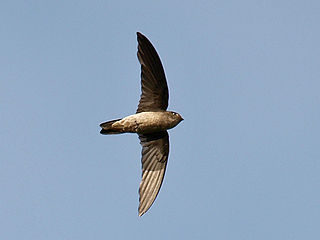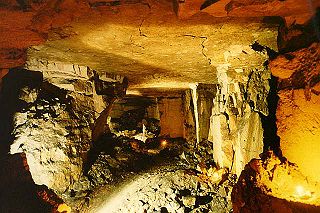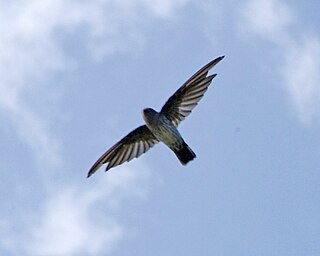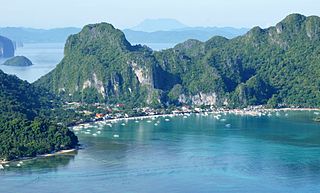
The Apodidae, or swifts, form a family of highly aerial birds. They are superficially similar to swallows, but are not closely related to any passerine species. Swifts are placed in the order Apodiformes along with hummingbirds. The treeswifts are closely related to the true swifts, but form a separate family, the Hemiprocnidae.

Swiftlets are birds from the four genera Aerodramus, Collocalia, Hydrochous and Schoutedenapus, which form the tribe Collocaliini within the swift family Apodidae. The group contains around thirty species mostly confined to southern Asia, south Pacific islands, and northeastern Australia, all within the tropical and subtropical regions. They are in many respects typical members of the Apodidae, having narrow wings for fast flight, with a wide gape and small reduced beak surrounded by bristles for catching insects in flight. What distinguishes many but not all species from other swifts and indeed almost all other birds is their ability to use a simple but effective form of echolocation to navigate in total darkness through the chasms and shafts of the caves where they roost at night and breed.

Aerodramus is a genus of small, dark, cave-nesting birds in the Collocaliini tribe of the swift family. Its members are confined to tropical and subtropical regions in southern Asia, Oceania and northeastern Australia. Many of its members were formerly classified in Collocalia, but were first placed in a separate genus by American ornithologist Harry Church Oberholser in 1906.

The Kinabatangan River is a river in Sandakan Division, in eastern Sabah, Malaysia. It is the second longest river in Malaysia, with a length of 560 km from its headwaters in the mountains of southwest Sabah to its outlet at the Sulu Sea, east of Sandakan. The area is known for its high biodiversity, including its limestone caves at Gomantong Hill, dryland dipterocarp forests, riverine forest, freshwater swamp forest, oxbow lakes, and salty mangrove swamps near the coast.

Madai Cave is a cave located in Kunak, Sabah, Malaysia. It is an integral part of the limestone hills range located within the Baturong Madai Forest Reserve.

Browne's Folly, or Brown's Folly, is a folly tower sitting within a 39.9 hectare biological and geological Site of Special Scientific Interest (SSSI) near the English village of Bathford in Somerset, notified in 1974: the site itself is known as the Farleigh Down Stone Quarry and is managed as a nature reserve by the Avon Wildlife Trust (AWT). The tower was built in 1848 and is a Grade II listed building.

The edible-nest swiftlet, also known as the white-nest swiftlet, is a small bird of the swift family which is found in Southeast Asia. Its opaque and whitish bird nest is made exclusively of solidified saliva and is the main ingredient of bird's nest soup, a delicacy of Chinese cuisine. Germain's swiftlet is now treated as conspecific with this species.
The mountain swiftlet is a species of swift in the family Apodidae. It is endemic to the island of New Guinea and the nearby islands of Karkar, Yapen and Goodenough. It was once placed in the genus Collocalia but has been moved, with many others, to Aerodramus. The species is divided into three subspecies, with the nominate, A. h. hirundinacea ranging over most of New Guinea, the subspecies A. h. excelsus occurring over 1600 m in the Snow Mountains and Cartenz peaks of Irian Jaya and A. h. baru being restricted to Yapen Island. It occurs in alpine areas from 500 m to the treeline. Its natural habitat is tropical moist montane forests and other mountainous habitats in New Guinea. It also occurs in lower numbers in the lowlands near hills.
The Tahiti swiftlet or Polynesian swiftlet is a species of swift in the family Apodidae. While often compared to the Marquesan Swiftlet, this bird is often more pale faced. The subspecies is the Monotypic which means it does not include a subspecies.

The cave swiftlet or linchi swiftlet is a species of swift in the family Apodidae. It is found on the Indonesia islands of Sumatra, Java and Bali. It is a woodland species and nests in caves. The Bornean swiftlet was considered a subspecies, but is now usually considered distinct.

The black-nest swiftlet is a species of swift in the family Apodidae. It is found in Brunei, Indonesia, Malaysia, Myanmar, the Philippines, Singapore, Thailand, and Vietnam. Its natural habitats are subtropical or tropical moist lowland forest and subtropical or tropical moist montane forest.
The giant swiftlet, also known as the waterfall swift, is a species of bird in the swift family, Apodidae. It is the only member of the monotypic genus Hydrochous. It is found in Malaysia, Sumatra and Java, where its natural habitats are subtropical or tropical moist montane forests and rivers. It is threatened by habitat loss.

The wrinkle-lipped free-tailed bat is a species of bat in the family Molossidae. It is found in Bangladesh, Bhutan, Cambodia, China, Cocos (Keeling) Islands, India, Indonesia, Laos, Malaysia, Myanmar, Nepal, the Philippines, Sri Lanka, Thailand and Vietnam.

The Andaman horseshoe bat is a species of bat in the family Rhinolophidae. It is endemic to the Andaman Islands. During the day, it roosts in caves, but may also choose tree hollows.

Deer Cave, located near Miri, Sarawak, Malaysia, is a show cave attraction of Gunung Mulu National Park. It was surveyed in 1961 by G. E. Wilford of the British Borneo Geological Survey, who predicted that Mulu would yield many more caves in the future. The cave, which is also known as Gua Payau or Gua Rusa by the local Penan and Berawan people, is said to have received its name because of the deer that go there to lick salt-bearing rocks and shelter themselves.
The Mantanani Islands are a group of three islands off the north-west coast of the state of Sabah, Malaysia, opposite the town of Kota Belud, in northern Borneo. The largest island is Mantanani Besar; the other two are Mantanani Kecil and Lungisan. It is a popular site for recreational diving and is known for its dugongs.

Edible bird's nests, also known as swallow nests, are bird nests created from solidified saliva by edible-nest swiftlets, Indian swiftlets and other swiftlets of the genera Aerodramus, Hydrochous, Schoutedenapus and Collocalia, which are harvested for human consumption.

The Kinabatangan District is an administrative district in the Malaysian state of Sabah, part of the Sandakan Division which includes the districts of Beluran, Kinabatangan, Sandakan, Telupid and Tongod. The capital of the district is in Kinabatangan Town.
The Bornean woolly horseshoe bat or Proconsul's horseshoe bat is an endangered species of horseshoe bat found on Borneo. Though it was discovered in 1959, it was not recognized as a distinct species until 2013.

A busyador or a swift nest collector is a person who harvests edible bird's nests in Southeast Asia, and particularly in the Philippines. The nests are made of the birds' solidified saliva, and serve as the main ingredient of bird's nest soup, a delicacy of Chinese cuisine.
















